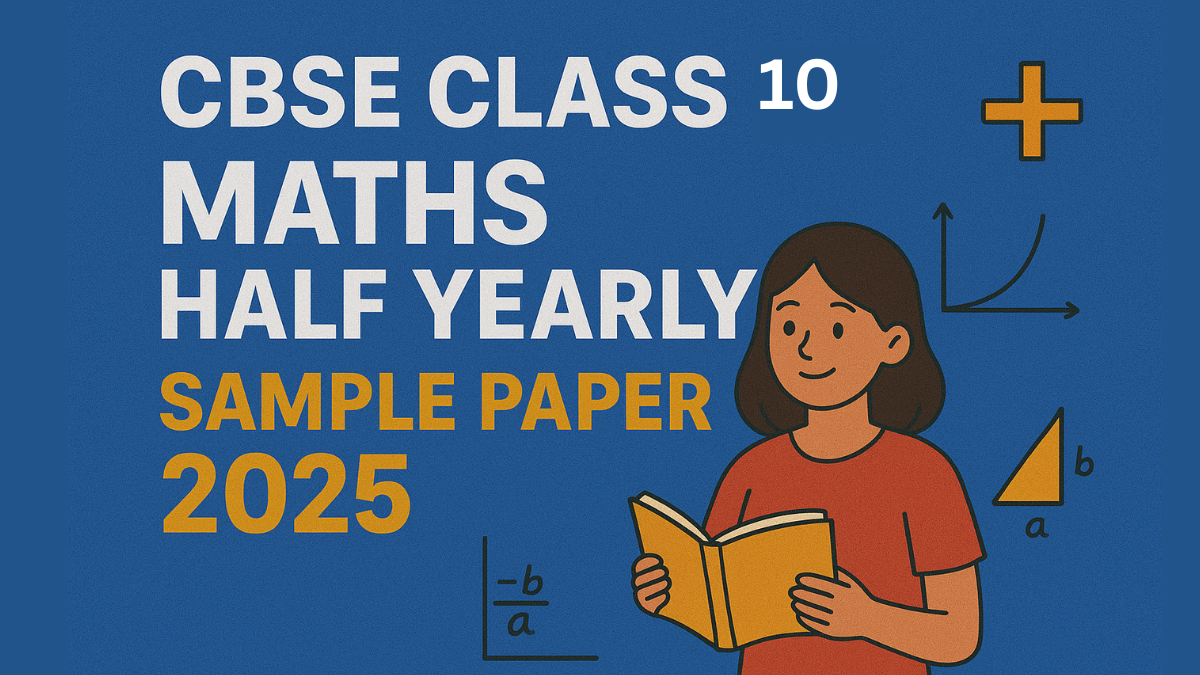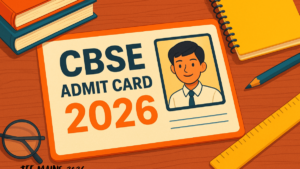CBSE Class 10 Maths Half Yearly Question Paper 2025: Most Class 10 students are nervous about their Mathematics exam because of its difficulty and extensive syllabus. Most students are unable to complete the arithmetic syllabus right before the midterm exams. So, on this page, Adda Education has supplied the CBSE Maths Half Yearly Sample Paper 2025 with Solutions. This Maths half question paper is based on the most recent exam pattern and includes all of the frequently asked question types during the last five years.
Using the Class 10 Maths Half Yearly Question Paper 2025 (Sample), you may become familiar with the actual exam pattern and comprehend the format, marking scheme, and various types of questions. Practice Class 10 Maths Half Yearly Sample Paper 2025 as much as possible to achieve a good result on the future exam.
Class 10 Maths Half Yearly Sample Paper 2025
The CBSE Class 10 Maths Half Yearly Sample Paper 2025 serves as a revision guide, ensuring that students focus on important areas while honing their problem-solving skills. Practising these Sample question papers helps students understand the types of questions to expect, the weightage of different chapters, and how to manage their time successfully on the actual test. The CBSE Class 10 Maths Half Yearly Exam 2025-26 Question Paper with Detailed Solutions PDF is available here.
CBSE Class 10 Maths Half Yearly Question Paper 2025 Pattern
Before moving towards solving the question paper, let’s take a quick look at the general instructions that each and every students need to minutely follow.
- The Total marks of the CBSE Class 10 Maths Sample Paper are 80 Marks
- Candidates have provided three hours or 180 minutes to write the exam.
- This question paper contains 38 questions. All Questions are compulsory.
- This Question Paper is divided into 5 Sections: A, B, C, D, and E.
- In Section A, Question numbers 1-18 are multiple choice questions (MCQs) and questions no. 19 and 20 are Assertion-Reason based questions of 1 mark each.
- In Section B, Question numbers 21-25 are very short answer (VSA) type questions, carrying 02 marks each.
- In Section C, Question numbers 26-31 are short-answer (SA) type questions, carrying 03 marks each.
- In Section D, Question numbers 32-35 are long-answer (LA) type questions, carrying 05 marks each.
- In Section E, Question numbers 36-38 are case study-based questions carrying 4 marks each with sub parts of the values of 1, 1 and 2 marks each respectively.
- There is no overall choice. However, an internal choice in 2 questions of Section B, 2 questions of Section C and 2 questions of Section D has been provided. An internal choice has been provided in all the 2 marks questions of Section E.
- Draw neat and clean figures wherever required. Take 𝜋 = 22/7 wherever required if not stated.
- Use of calculators is not allowed.
| Also Check | |
| CBSE Class 10 SST Half Yearly Sample Paper | CBSE Class 10 Science Half Yearly Sample Paper |
Class 10 Maths Chapter-Wise Weightage
The CBSE Class 10 Maths Weightage for 2025-26 includes a chapter-by-chapter mark distribution, which can be seen on the CBSE website, while the weightage is based on the previous year’s analysis. Before moving to practicing the sample paper, let’s take a look at the CBSE Class 10 Maths Chepter wise weihghtage for a stregic preparation.
| Units | Unit Name | Marks |
| I | NUMBER SYSTEMS | 6 |
| II | ALGEBRA | 20 |
| III | COORDINATE GEOMETRY | 6 |
| IV | GEOMETRY | 15 |
| V | TRIGONOMETRY | 12 |
| VI | MENSURATION | 10 |
| VII | STATISTICS & PROBABILITY | 11 |
| Total | 80 |
Maths Half Yearly Sample Paper Class 10 2025 with Solutions
The latest question with answers of Maths Half Yearly Sample Papers are shared below.
| SECTION – A (Section A consists of 20 questions of 1 mark each) |
Q.1 Find the value of k for which the system of equations x + (k + 1)y = 5 and (k + 1)x + 9y = 8k − 1 has
infinitely many solutions (1 Mark)
(a) 2 (b) 3 (c) 4 (d) 5
Ans. (a) 2
Q.2 The quadratic equation x² + 5x − 2 = 0 has (1 Mark)
(a) two distinct real roots
(b) two equal real roots
(c) no real roots
(d) more than 2 real roots
Ans. (a) two distinct real roots
Q.3 ΔABC~ΔPQR. If AM and PN are altitudes of ΔABC and ΔPQR, respectively, and AB² : PQ² = 25: 36, then
AM: PN = (1 Mark)
(a) 2:5 (b) 5:6 (c) 25:36 (d) 2:3
Ans. (b) 5:6
Q.4 The quadratic polynomial, the sum of whose zeroes is -5 and product is 6, is, (1 Mark)
(a) x² + 5x + 6
(b) x² − 5x + 6
(c) x²− 5x − 6
(d) −x² + 5x + 6
Ans. (a) x² + 5x + 6
Q.5 ΔPQR is shown below. ST is drawn such that ∠PRQ = ∠STQ (1 Mark)

If ST is divided QR in a ratio of 2: 3, then what is the length of ST?
(a) 10/3cm
(b) 8 cm
(c) 12 cm
(d) 40
Ans. (b) 8 cm
Q.6 P, (5,1), Q (1,4) and R (8,5) are the coordinates of the vertices of a triangle. Which of the following types of triangles will ΔPQR be (1 Mark)
(a) equilateral triangle (b) Scalene (c) Isosceles (d) None
Ans. (c) Isosceles
Q.7 If – 2 and 3 are the zeroes of the quadratic polynomial x
2 + (p + 1)x + q, then p and q are… respectively
(a) -7,3 (b) -6, -2 (c) 2,6 (d) -2,-6 (1 Mark)
Ans. (d) -2,-6
Q.8 A point (x y) is at a distance of 7 units from the origin. How many such points lie in the third quadrant?
(a) 0 (b) 1 (c) 2 (d) Infinitely many (1 Mark)
Ans. (d) Infinitely many
Q.9 The value of k for which the system of equation x + y − 4 = 0 and 2x + ky = 3 has no. solution is
(a) -2 (b) ≠2 (c) 3 (d) 2 (1 Mark)
Ans (d) 2
Q.10 The 11th term of an AP ; −5, −5, … .. (1 Mark)
(a) -20 (b) 30 (c) 20 (d) -30
Ans (c) 20
Q.11 If g − 1, g + 3 and 3g − 1 are in A.P, then find the value of g. (1 Mark)
(a) 3 (b) 4 (c) 5 (d) 7
Ans. (b) 4
Q.12 Which of the following is equal to the given expression? (1 Mark)
(cotθ sec2 θ) / cosec θ =?
(a) sec θ
(b) cosec θ
(c) cot2 θ sec θ
(d) cot2 θ cosec θ
Ans. (a) sec θ
Q.13 If the n th term of an AP is given by an = 5n − 3, then the sum of the first 10 term is (1 Mark)
(a) 225
(b) 245
(c) 255
(d) 270
Ans. (b) 245
Q.14 Find the 11th term from the end of the given progression 10 , 7, 4….. -62. (1 Mark)
(a) -32 (b) -16 (c) -25 (d) 0
Ans. (a) -32
Q.15 Shown below is a solved trigonometric problem. (1 Mark)
 In which step is there an error in solving?
In which step is there an error in solving?
(a) Step 1 (b) Step 2 (c) Step 3 (d) There is no error
Ans. (a) Step 1
Q.16 In triangles ABC and DEF, ∠B, ∠E, ∠F = ∠C, and AB = 3DE. Then the two triangles are. (1 Mark)
(a) congruent but not similar. (b) similar but not congruent
(c) neither congruent nor similar (d) congruent as well as similar
Ans. (b) similar but not congruent
Q.17 What is the HCF of the least prime number and the least composite number (1 Mark)
(a) 1 (b) 2 (c) 3 (d) 4
Ans. (b) 2
Q.18 √n is a natural number such that n > 1. Which of these can definitely be expressed as a product of
primes? (1 Mark)
(i) √n (ii) n (iii) √n
(a) only (i) (b) only (i) and (ii) (c) all (i), (ii) and (iii) (d) None of these
Ans. (c) all (i), (ii) and (iii)
DIRECTIONS: In the question number 19 and 20, a statement of Assertion (A) is followed by a statement of Reason (R).
Choose the correct option:
(A)Both assertion (A) and reason (R) are true and reason (R) is the correct explanation of assertion
(B)Both assertion (A) and reason (R) are true and reason (R) is not the correct explanation of assertion (A)
(C)Assertion (A) is true but reason (R) is false.
(D)Assertion (A) is false but reason (R) is true.
Q.19 Statement A (Assertion): HCF of 26 and 91 is 13 and the LCM is 182. (1 Mark)
Statement R (Reasons) As HCF (a, b) X (a x b) = LCM (a, b)
Ans. (C) Assertion (A) is true, but reason (R) is false.
Q.20 Assertion (A): The mid-point of a line segment divides it in ratio 1: 1. (1 Mark)
Reason (R): Three points are collinear if they lie on the same straight line.
Ans. (B) Both assertion (A) and reason (R) are true and reason (R) is not the correct explanation of assertion (A)
| SECTION – B (Section B consists of 6 questions of 2 mark each) |
Q.21 Solve for x and y 71𝑥 + 37𝑦 = 253 (2 Marks)
37𝑥 + 71𝑦 = 287
Ans.

Q.22 A line intersects the y-axis and x-axis at the points P and Q respectively. If (2, -5) is the mid-point of PQ then find the coordinates of P and Q. (2 Marks)
Ans.

Q.23 Using the fundamental theorem of Arithmetic, final HCF and LCM of 6, 72 and 120. (2 Marks)
Ans.
 Q.24 Find the ratio in which the point (-3, p) divides the line segment joining the point (-5, -4) and (-2, -3).
Q.24 Find the ratio in which the point (-3, p) divides the line segment joining the point (-5, -4) and (-2, -3).
Also find the value of p. (2 Marks)
Ans.24
 Q.25 Find a quadratic polynomial whose zeros are (3 + √3) and (3 − √3) (2 Marks)
Q.25 Find a quadratic polynomial whose zeros are (3 + √3) and (3 − √3) (2 Marks)

Last-Minute Tips for Class 10 Maths Half Yearly Exam
With the Class 10 Maths Half Yearly Exam coming up, smart revision is the key. Start by revising all the important formulas and theorems—they are the base of most questions. Make a separate sheet of formulas for quick reference and go through it often.
Next, solve sample papers and previous year papers. This helps you understand the exam pattern, marking scheme, and improves your speed. Always time yourself and try to finish within the given time.
Focus more on chapters with higher weightage and revise weak areas instead of starting new topics at the last minute. While writing answers, show all steps clearly, as marks are also given for proper working.
Finally, keep calm, avoid stress, and get good sleep before the exam. A clear mind, regular practice, and smart revision will boost your confidence and help you score well.
The key to success as the Class 10 Maths Half Yearly Exam approaches is effective revision. Below, we have shared some last-minute Tips for the Class 10 Maths Half-Yearly Exam
- Begin by reviewing all of the essential formulas and theorems, as most questions are based on them. Create a separate document for simple formula reference and review it on a regular basis.
- Next, review previous years’ papers and practice sample papers to improve your problem-solving abilities and obtain a better understanding of the grading scheme and question format. This will also enhance your confidence in the actual test.
- When working on these assignments, be conscious of time management; set a timer and try to complete them within the allotted time.
- Instead of choosing new topics from the syllabus at the last minute, evaluate your weaknesses and make immediate changes.
- Focus on chapters with a larger weightage and ensure your steps are properly defined, as scores are rewarded for proper work. Finally, relax your thoughts, prevent stress, and get plenty of sleep before the exam.
- A clear mind, paired with effective revision and practice, can help you score high and perform confidently.
Importance of Practicing Sample Papers
Practicing sample papers is essential for many reasons:
- Helps in understanding the exam pattern and marking scheme.
- Identifies weak areas that need more focus and practice.
- Improves time management skills during the exam.
- Boosts confidence and reduces exam anxiety.
- Provides exposure to different types of questions.
| Related Posts | |
| CBSE Class-10 Maths PYQs | CBSE Class 10 Maths sample paper |
| Class 10 Maths Question Paper 2025 | CBSE Class 10th Maths Syllabus |










 CBSE Admit Card 2026 for Private & R...
CBSE Admit Card 2026 for Private & R...
 AILET 2026 AIR 1: Check Full Toppers Lis...
AILET 2026 AIR 1: Check Full Toppers Lis...
 AILET Result 2026 OUT, How to Download S...
AILET Result 2026 OUT, How to Download S...






